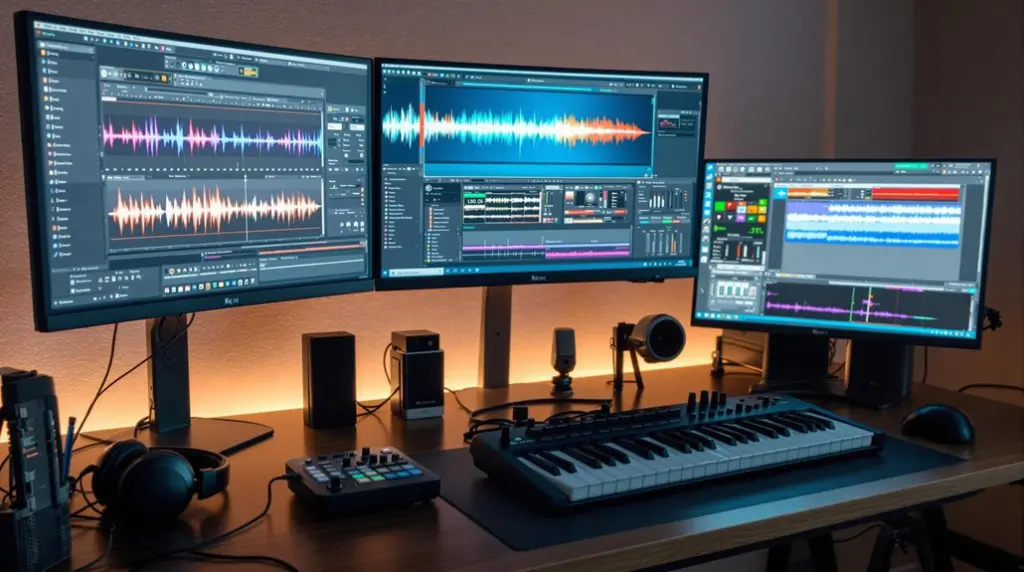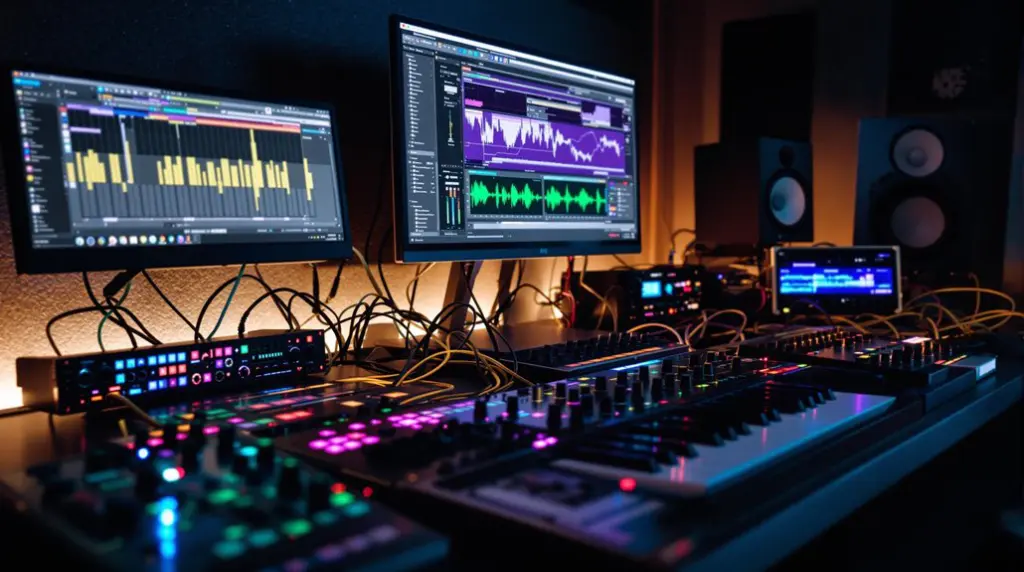The Behringer Model D synthesizer impresses with its robust design (90 x 374 x 136 mm, 1.7 kg) and firm, smooth knobs, ensuring excellent tactile feedback. It offers rich, authentic analog sound with three oscillators producing six waveform options. Oscillator 3 as a modulation source enhances tonal control. The dual-mode 24dB/octave filter adds depth with low-pass and high-pass configurations. Connectivity includes MIDI-to-CV conversion and MIDI polychain support, although some pitch bend issues can affect performance. Priced competitively at $299, it’s a strong value for analog synthesizer enthusiasts. To explore more in-depth aspects, further information is provided.
Key Takeaways
- Offers three VCOs generating six distinct waveforms, enabling versatile sound design.
- Dual-mode 24dB/octave resonant filter provides rich harmonic content and self-oscillation.
- Priced at $299, it delivers excellent value for vintage tones and modern reliability.
- MIDI-to-CV conversion supports modular integration with MIDI controllers.
- Compact and durable design with firm, smooth knobs enhances the tactile user experience.
Design and Build Quality
Design and Build Quality
Although compact in size, the Behringer Model D impresses with its robust design and solid build quality. Measuring 90 x 374 x 136 mm and weighing a mere 1.7 kg, the Model D’s portability makes it an excellent choice for both studio and stage environments. Constructed from high-quality build materials, the unit exudes durability, with a finishing quality that has garnered positive feedback for its resilience and aesthetic appeal.
The design incorporates firm and smooth knobs that offer a satisfying tactile experience, enhancing the overall user interaction. Additionally, the user-friendly interface of the Model D complements its portability, making it accessible for musicians of all skill levels. However, the closely spaced knob layout presents some challenges. Users with larger hands may find it difficult to make precise adjustments without inadvertently altering adjacent settings, a minor drawback that could impact usability during intricate performance scenarios.
A notable feature is the unique sliding eye mechanism for securing screws, which deviates from traditional rack rail systems. This innovation not only provides stability but also guarantees seamless Eurorack compatibility, a significant advantage for modular synthesizer enthusiasts.
Despite minor concerns regarding panel connection stability, the overall design and build quality of the Behringer Model D remain commendable, balancing durability with user-friendly features.
Sound Quality
When it comes to sound quality, the Behringer Model D excels in delivering a powerful and authentic analog experience. Renowned for its ability to closely mimic the iconic tones of the Minimoog Model D, this synthesizer is a favored choice for creating synth basses and leads.
The Model D’s three oscillators, capable of producing six distinct waveforms including triangle, ramp, and pulse variants, offer users versatile sound design options. This flexibility is further enhanced by the dual-mode resonant 24dB/oct filter, which provides both low-pass and high-pass modes, allowing for thorough sound shaping. Remarkably, the Moog Minimoog features a similar 24dB transistor ladder filter, which has been instrumental in its iconic sound.
The combination of voltage-controlled oscillators (VCOs) and the filter produces a rich and fat analog sound, adept at generating everything from ambient textures to harsh noise and robust bass output. The filter’s self-oscillation capabilities, extending down to 64Hz, add another layer of depth to the sound design.
In synth comparisons, the Model D’s sound quality has been favorably matched against vintage tones, making it an excellent value at its price point of $299. Overall, the Behringer Model D stands out for its ability to deliver vintage tones with modern reliability and affordability.
Oscillators and Mixer
The Behringer Model D’s oscillators are notable for their extensive waveform variety, offering six distinct options such as triangle, ramp, and pulse waves, which greatly enhance sound design capabilities.
With a detune range of -9 to +8 semitones, these oscillators allow for the creation of rich and complex timbres.
Additionally, the flexibility of Oscillator 3 as a modulation source, coupled with the precise blending capabilities of the mixer section, guarantees a high degree of control over the tonal character, making it an excellent tool for both classic and innovative soundscapes.
Waveform Variety Options
Among its numerous features, the Behringer Model D excels in offering a diverse array of waveform options through its three voltage-controlled oscillators (VCOs). Each VCO is capable of producing five distinct waveforms: sawtooth, pulse, triangle, and noise, providing a broad spectrum of waveform characteristics vital for sound shaping. This versatility allows users to craft a wide range of sonic textures, from sharp, cutting leads to smooth, mellow pads.
The integration of a mixer section for these oscillators further enhances the Model D’s sound design capabilities. Users can blend the outputs of all three oscillators, adjusting individual levels to create complex timbres. This mixer functionality is essential for achieving unique soundscapes and rich harmonic content.
Additionally, Oscillator 3’s ability to function as a modulation source adds another layer of flexibility, enabling intricate modulation effects by tracking the keyboard or maintaining a constant rate.
The Model D’s oscillators are noted for their sound quality, closely resembling the vintage Minimoog oscillators that synth enthusiasts highly regard. This analog authenticity, combined with the waveform variety and blending options, positions the Behringer Model D as a powerful tool for detailed and dynamic sound shaping.
Detune Capabilities Range
How does the Behringer Model D achieve its remarkable detune capabilities? The Model D features three oscillators, each capable of a detune range from -9 to +8 semitones, providing extensive tonal variation. This range allows for intricate detune techniques that can emulate vintage Minimoog sounds, highly valued by synthesizer enthusiasts.
The oscillators generate six distinct waveforms—triangle, ramp, and three pulse variants—each contributing uniquely to the detune effects. This waveform diversity enriches the soundscapes, making the Model D versatile in producing both subtle and pronounced detune effects. Oscillator 3 further expands detune capabilities by serving as a modulation source while either tracking the keyboard or maintaining a constant rate.
The built-in mixer plays an essential role by blending the outputs from the three oscillators. By carefully adjusting their levels, users can craft complex, detuned sounds that are both rich and dynamic. This meticulous blending is vital for achieving authentic analog experiences reminiscent of vintage synthesizers.
| Feature | Description |
|---|---|
| Oscillator Range | -9 to +8 semitones |
| Waveforms | Triangle, ramp, pulse variants |
| Oscillator 3 | Modulation source, keyboard tracking |
| Mixer Function | Blends oscillators for complex tones |
| Vintage Emulation | Accurate analog sound replication |
Modulation Source Flexibility
Building on the extensive detune capabilities, the modulation source flexibility of the Behringer Model D greatly enhances its sonic versatility. Central to this flexibility are the three voltage-controlled oscillators (VCOs), each capable of generating six distinct waveforms, including triangle, ramp, and pulse. This variety of waveforms allows for a multitude of modulation techniques to be employed, facilitating a broad spectrum of sound design possibilities.
A notable feature is the ability of Oscillator 3 to function as a modulation source. It can either track the keyboard or maintain a constant rate, thereby offering unique modulation capabilities that can be finely tuned to the user’s needs. This flexibility in modulation routing is critical for creating dynamic and evolving soundscapes.
The mixer section further augments modulation source flexibility by enabling the blending of the three oscillator outputs. This feature allows for intricate sound creation through precise adjustments of levels and panning.
Additionally, with 13 patch points for modular connectivity, users can introduce external modulation sources, thereby expanding the internal capabilities of the oscillators and mixer. This seamless integration fosters an expansive modulation environment, making the Behringer Model D a powerful tool for both traditional and experimental synthesis.
Filter Functions
The filter functions of the Behringer Model D are a demonstration of its sophisticated engineering and commitment to sonic versatility. At its core, the Model D features a dual-mode resonant 24dB/octave filter capable of operating in both low-pass and high-pass configurations, providing users with extensive sound-sculpting options.
Remarkably, this filter can self-oscillate, producing sine wave tones at frequencies as low as 64Hz, which is lower than the vintage Minimoog Model D.
A detailed analysis of the Model D’s filter reveals several key factors:
- Filter Resonance: The resonant capabilities of the filter are exceptional, allowing for rich harmonic content and emphasizing frequencies with precision. This is instrumental in achieving a wide array of sonic textures.
- Filter Tracking: While the filter tracking can be slightly inaccurate across the keyboard range, careful tweaking can yield ideal performance, closely emulating the sound response of vintage Minimoog models.
- Sound Quality: The filter’s design is pivotal in producing warm, rich tones, making it suitable for various musical applications, from basslines to ambient textures.
- Versatility: The dual-mode filter enhances the Model D’s flexibility, enabling producers to utilize it in diverse musical scenarios effectively.
Modulation Capabilities
Although the Behringer Model D is often celebrated for its vintage analog sound, its modulation capabilities are equally impressive and integral to its versatility. The synthesizer’s design includes three oscillators capable of producing six different waveforms—triangle, ramp, and pulse, to name a few—offering a broad spectrum for modulation techniques.
Oscillator 3 stands out as a versatile modulation source; it can either track the keyboard’s pitch or operate at a constant rate, providing enhanced flexibility for sound design. Additionally, the intelligent composition tools can be integrated with the Model D’s modulation capabilities, allowing for innovative compositions and enhanced music creation.
The Model D’s 13 patch points further extend its modulation capabilities, allowing users to integrate external modulation sources and other gear. This modular connectivity opens up possibilities for intricate and complex sound creation, making it a robust tool for any synthesist.
The dual-mode resonant 24dB/oct filter, which supports both low-pass and high-pass modes and features self-oscillation, allows for dynamic modulation effects that can greatly alter the tonal characteristics of the sound.
Additionally, MIDI polychain support permits linking up to 16 Model D units, exponentially expanding modulation and layering capabilities. This feature is particularly beneficial for creating rich, textured soundscapes, solidifying the Model D’s standing as a versatile and powerful synthesizer.
Connectivity and MIDI
The Behringer Model D offers robust connectivity with high and low audio outputs and DIP switches for streamlined MIDI channel selection, enhancing its adaptability in diverse setups.
While it supports basic MIDI modulation, users may encounter issues such as triggering inconsistencies during rapid play and limitations with pitch bend functionality.
Additionally, its Eurorack compatibility allows for modular integration, though extensive configuration requires the use of the “Configurator Model D” GUI tool.
MIDI Channel Selection
Selecting the appropriate MIDI channel on the Behringer Model D is a straightforward process thanks to its use of DIP switches. These switches allow users to easily configure the synthesizer to respond to specific MIDI channels, which is particularly useful in a multi-unit setup.
This MIDI configuration is essential for ensuring performance reliability, especially when integrating the Model D into a more extensive system.
The MIDI implementation on the Model D includes basic System Exclusive (SysEx) commands that enable a certain level of communication with external devices, though it is somewhat limited compared to more advanced synthesizers. Users can link up to 16 units using MIDI polychain support, creating a polyphonic synthesizer setup that greatly expands sound design possibilities.
Key features of the Behringer Model D’s MIDI capabilities include:
- DIP Switches for MIDI Channel Selection: Simple and effective for configuring specific MIDI channels.
- SysEx Command Support: Enables basic external communication, enhancing integration with other equipment.
- MIDI Polychain Support: Connect up to 16 units for expanded polyphony.
- MIDI-to-CV Conversion: Sends MIDI note information to CV and Gate outputs, facilitating modular gear integration.
However, it’s worth noting that the Model D has been reported to have issues with triggering new notes during rapid play, which could impact performance reliability.
Audio Output Options
High-quality audio output options on the Behringer Model D provide users with flexible integration into a variety of audio systems and mixing setups. The synthesizer includes both high and low audio output options, catering to different output levels and ensuring compatibility with a wide range of equipment.
This flexibility is essential for seamless audio integration, whether the Model D is incorporated into a home studio or a professional production environment.
The back panel of the Behringer Model D features DIP switches, which are instrumental in selecting the MIDI channel. This configuration process is straightforward, allowing for efficient synchronization with MIDI controllers and other devices.
The synthesizer’s external 12V DC power supply contributes to stable performance, maintaining consistent output levels during extended use.
Furthermore, the MIDI implementation on the Model D, while described as thorough, is somewhat restricted by its limitation to basic SysEx commands. This can hinder advanced configuration for certain users.
However, the connectivity is enhanced by MIDI polychain support, which permits linking up to 16 units. This feature is particularly valuable for those seeking to expand the polyphonic capabilities of their setup, offering a substantial degree of audio integration flexibility.
Pitch Bend Issues
Addressing the pitch bend issues on the Behringer Model D reveals a range of inconsistencies that can greatly impact performance.
Users have reported that the pitch bend functionality is particularly unreliable when triggered rapidly, which can disrupt the fluidity of live performances and lead to noticeable performance impact. This is compounded by limitations in MIDI performance, where triggering new notes while a previous note is still sustaining often leads to erratic behavior, further diminishing playability.
Several critical areas where the pitch bend issues manifest include:
- Rapid Triggering: Inconsistencies become more pronounced during rapid pitch bends, leading to unpredictable results.
- MIDI Implementation: Despite claims of extensive MIDI capabilities, the Model D struggles with accurate pitch bend control, essential for expressive playing.
- CV and Gate Connections: Pitch bend issues extend to CV and gate connections, complicating integration with modular systems and frustrating users seeking seamless connectivity.
- Live Performance Reliability: The less reliable pitch bend functionality compared to traditional synthesizers can be particularly frustrating during live performances, where consistency is paramount.
These issues collectively underscore the need for prospective users to weigh the potential performance impact and user frustration against the otherwise impressive sonic capabilities of the Behringer Model D.
User Experience and Value
Through its impressive average user rating of 4.7 out of 5 from 309 customer ratings, the Behringer Model D clearly demonstrates its strong user approval, particularly for its features and sound quality. User feedback highlights the engaging experience the Model D offers, allowing for extensive experimentation with sound layering and effects without the constraints of preset settings.
This flexibility is particularly appreciated by users who enjoy a playful, hands-on approach to sound synthesis. The Model D’s versatility and sound design capabilities are also comparable to resources offered by top music production channels.
The compact design of the Model D caters to users with smaller hands, making it suitable for both studio work and live performances. Its versatility is further underscored by its recommendation from music educators as an excellent starting point for beginners evolving into the world of modular synthesis, despite some initial overwhelm noted by new users.
From a pricing strategy perspective, the Model D’s competitive price point of $299 positions it as a strong value proposition. This pricing not only makes it accessible to a broad range of analog synthesizer enthusiasts but also guarantees that users receive significant features and sound quality for their investment.
Frequently Asked Questions
What Is the Behringer Model D?
The Behringer Model D is a monophonic analog synthesizer, designed to pay homage to the iconic Moog Minimoog Model D. Known for its rich synthesizer history, it features a classic analog design with versatile sound-shaping capabilities.
What Is the Behringer Model D Clone Of?
The Behringer Model D is a clone of the iconic Moog Minimoog Model D. It seeks to replicate the legendary analog sound of its predecessor, a cornerstone in synthesizer history, while offering an affordable alternative.
How Many HP Is Behringer Model D?
The Behringer Model D synthesizer specifications indicate it occupies 70HP in a Eurorack setup, efficiently utilizing its oscillator capabilities. Its compact dimensions and modular compatibility make it an excellent choice for both studio and live performance environments.
Does Behringer Poly D Sound Like a Moog?
The Behringer Poly D offers a sound comparison to Moog synthesizers, with similar synth characteristics such as rich, fat tones and a 24dB low-pass filter. However, its unique architecture and modulation capabilities result in distinct sound variations.
Conclusion
The Behringer Model D synthesizer exhibits robust design and build quality, delivering superior sound through its versatile oscillators and mixer. The filter functions offer precise tonal shaping, while modulation capabilities enhance sound design flexibility. Extensive connectivity and MIDI options guarantee seamless integration into diverse setups. Overall, the user experience is enriched by the instrument’s intuitive interface and cost-effective value, making the Model D a commendable choice for musicians and producers seeking a reliable, high-performance analog synthesizer.




